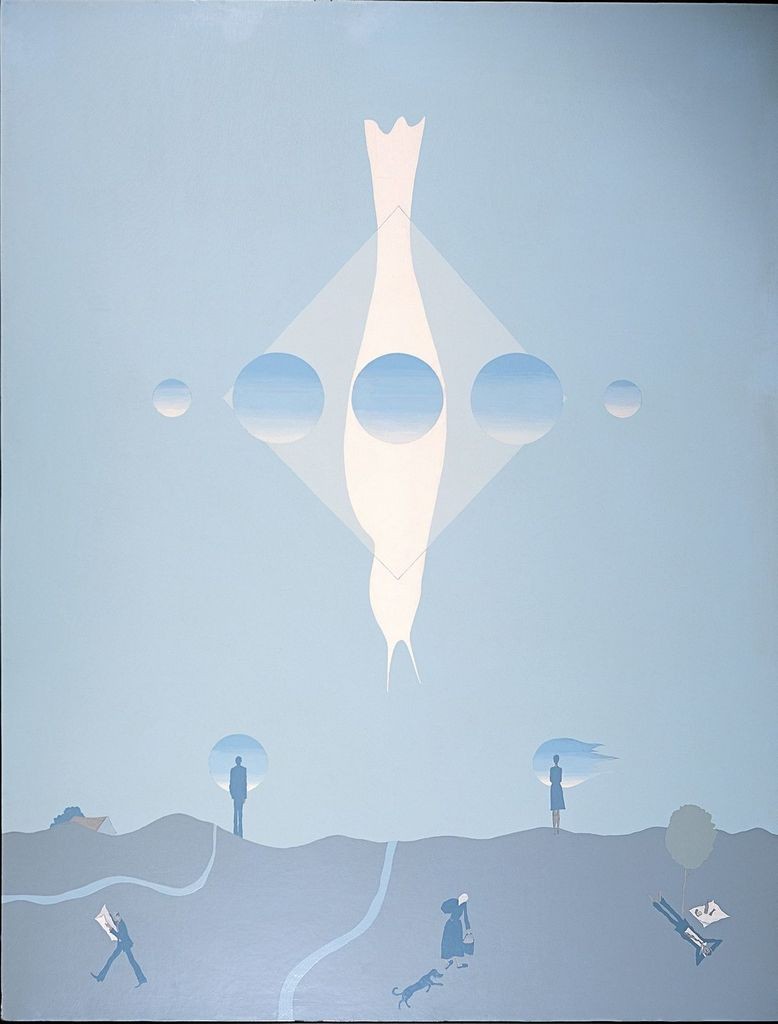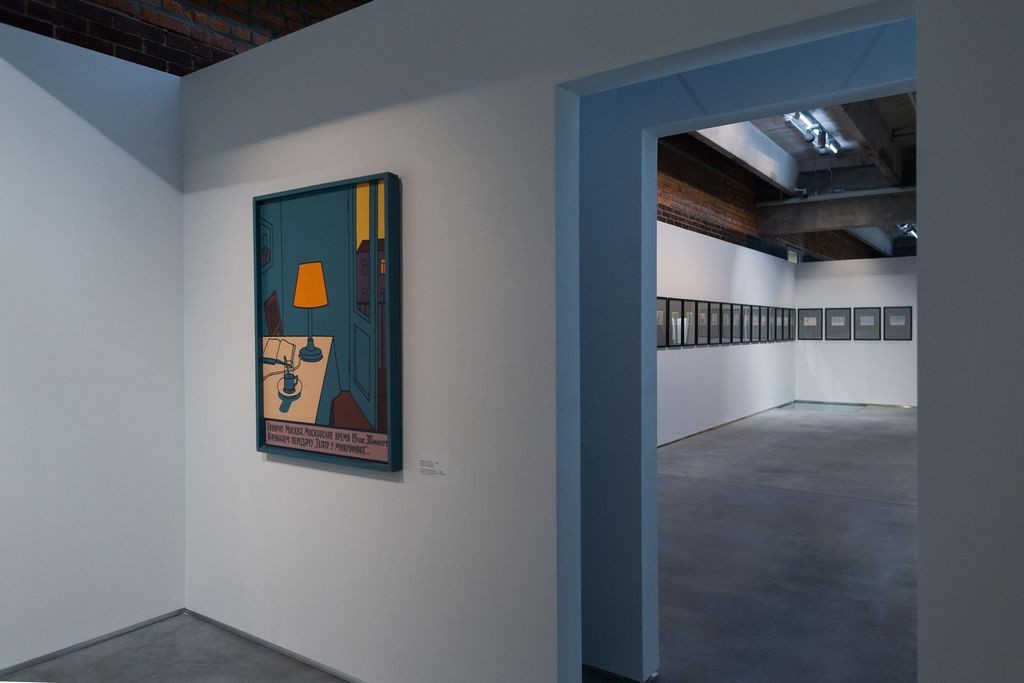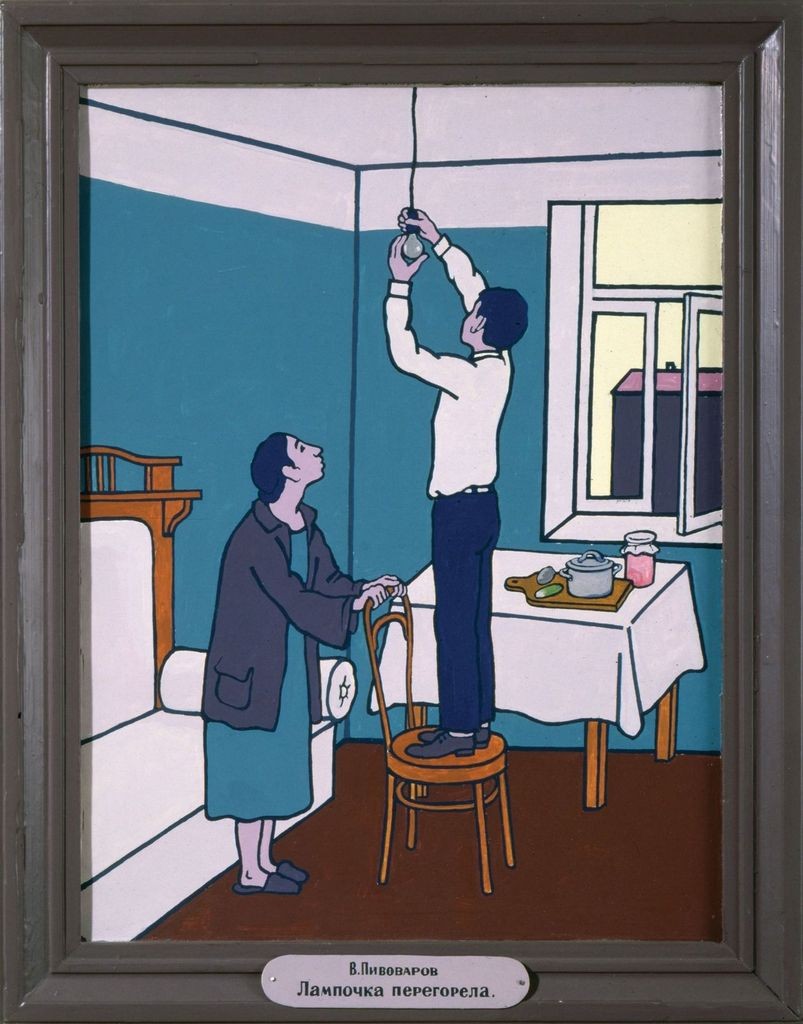Viktor Pivovarov
The Snail’s Trail
17 Mar - 18 Jun 2016

Installation view of Viktor Pivovarov: The Snail’s Trail
Garage Museum of Contemporary Art, Moscow, 2016
Photo: Egor Slizyak
Courtesy Garage Museum of Contemporary Art
Garage Museum of Contemporary Art, Moscow, 2016
Photo: Egor Slizyak
Courtesy Garage Museum of Contemporary Art

Viktor Pivovarov
White bird, 1977
Enamel on fibreboard
Courtesy of Museum of Avant-Garde Mastery (MAGMA)
White bird, 1977
Enamel on fibreboard
Courtesy of Museum of Avant-Garde Mastery (MAGMA)

Installation view of Viktor Pivovarov: The Snail’s Trail, Garage Museum of Contemporary Art, Moscow, 2016
Photo: Egor Slizyak
Courtesy Garage Museum of Contemporary Art
Photo: Egor Slizyak
Courtesy Garage Museum of Contemporary Art

Viktor Pivovarov
A bird reading in a landscape (after a picture by Carl Spitzweg), 1998
Oil on wood
Courtesy of ART4 Museum
A bird reading in a landscape (after a picture by Carl Spitzweg), 1998
Oil on wood
Courtesy of ART4 Museum

Viktor Pivovarov
Say “Uh-h-h!”, 2010
Assemblage, glass
Courtesy of Museum of Avant-Garde Mastery (MAGMA)
Say “Uh-h-h!”, 2010
Assemblage, glass
Courtesy of Museum of Avant-Garde Mastery (MAGMA)

Installation view of Viktor Pivovarov: The Snail’s Trail, Garage Museum of Contemporary Art, Moscow, 2016
Photo: Egor Slizyak
Courtesy Garage Museum of Contemporary Art
Photo: Egor Slizyak
Courtesy Garage Museum of Contemporary Art

Installation view of Viktor Pivovarov: The Snail’s Trail, Garage Museum of Contemporary Art, Moscow, 2016
Photo: Egor Slizyak
Courtesy Garage Museum of Contemporary Art
Photo: Egor Slizyak
Courtesy Garage Museum of Contemporary Art
VIKTOR PIVOVAROV
The Snail’s Trail
17 March – 18 June 2016
Garage Museum of Contemporary Art presents The Snail’s Trail by Viktor Pivovarov, in celebration of the artist’s forthcoming 80th birthday. Revealing the mesmerizing interior worlds which Pivoravov creates in his work as a painter, book designer, illustrator, theoretician, creator of conceptual albums, memoirist, and writer, the exhibition includes works from the mid-1970s through to recent paintings.
The exhibition is the first in which Pivovarov has collaborated with an architect to create an immersive environment, taking audiences on a journey through his highly personalized graphic style. Pivovarov directs the viewer through a series of eleven rooms, each of which reveals a particular emotional experience. These include extreme loneliness (such as in the series Projects for a Lonely Person, 1975; and The Gardens of Monk Rabinovich, 2012–2013); poetic love (the series June–June, 1978–1988); mystical adventures (the Eidos series, 2000–2009); horror and death (Sutra of Doubts and Fears, 2006). The exhibition guide, written by the artist, expands on the situations, themes, and devices he uses in his work.
Taking a new approach to traditional painting, Pivorarov has developed his own complex language—through the use of formal graphs and tables, and imagery reminiscent of children’s book illustrations, posters, and manuals—to depict symbolic riddles, which he leaves the viewer to solve. In addition to presenting a number of key paintings, a significant part of The Snail’s Trail is devoted to Pivovarov’s use of the conceptual album, an art form he pioneered with Ilya Kabakov in the late 1960s. Consisting of pages of images and paradoxical statements, these large-scale books were originally intended to be shown by the artist to individual viewers in a private setting. The two remaining parts of his Garden album (1976, originally in three parts, one of which was lost) will be exhibited together for the first time.
A key member of the Moscow Conceptualist movement—along with Erik Bulatov, Ilya Kabakov, and Andrey Monastyrsky—Pivovarov helped shape the Russian underground art scene from the 1960s. In contrast to his fellow Conceptualists, the artist has always focused on the secret, internalised life of the soul. Commenting on the title of the exhibition, Pivovarov says, “To me, the image of a snail with its shell coiled inward is a metaphor for the entire exhibition and for the introvert’s mind, spiraling deeper and deeper into the cosmos that is a human being.”
The title of the exhibition comes from a work which will be shown at the Pushkin State Museum of Fine Arts in Moscow in an exhibition developed and organized with the support of Garage. Viktor Pivovarov’s most recent series of paintings, Lost Keys, inspired by the Dutch masters of the 16th and 17th centuries, will be exhibited in the Pushkin Museum’s Michelangelo Gallery March 22–May 16, 2016.
Viktor Pivovarov was born in Moscow in 1937. He graduated from the Kalinin Moscow College of Art and Industry in 1957 and the Moscow Polygraphic Institute in 1962. Since 1982, he has lived and worked in Prague. Solo exhibitions include Cake and Lemon Eaters (with Ged Quinn), Galerie Rudolfinum, Prague (2014); Text – Bild – Konzept (with Pavel Pepperstein), Kunstverein Rosenheim, Rosenheim (2012); Ophelia (with Pavel Pepperstein), Regina Gallery, London (2012); THEY, Moscow Museum of Modern Art (2011); Temnye Komnaty, XL Gallery, Moscow (2004); Shagi Mekhanika, The State Tretyakov Gallery, Moscow, The Russian Museum, St. Petersburg (2004); Soňa a anděl, Galerie Rudolfinum, Prague (1996); Flat No. 22, Galerie der Stadt Wels, Wels (1990); Obraz a text, Dům umění města Brna, Brno (1990); Retrospektivní výstava, Lidový dům ve Vysočanech, Prague (1989); Koncert (with Ilya Kabakov), Neue Galerie, Götzental, Lucerne (1988); and Kresby a akvarely, Kulturní centrum Opatov, Prague (1988).
The Snail’s Trail
17 March – 18 June 2016
Garage Museum of Contemporary Art presents The Snail’s Trail by Viktor Pivovarov, in celebration of the artist’s forthcoming 80th birthday. Revealing the mesmerizing interior worlds which Pivoravov creates in his work as a painter, book designer, illustrator, theoretician, creator of conceptual albums, memoirist, and writer, the exhibition includes works from the mid-1970s through to recent paintings.
The exhibition is the first in which Pivovarov has collaborated with an architect to create an immersive environment, taking audiences on a journey through his highly personalized graphic style. Pivovarov directs the viewer through a series of eleven rooms, each of which reveals a particular emotional experience. These include extreme loneliness (such as in the series Projects for a Lonely Person, 1975; and The Gardens of Monk Rabinovich, 2012–2013); poetic love (the series June–June, 1978–1988); mystical adventures (the Eidos series, 2000–2009); horror and death (Sutra of Doubts and Fears, 2006). The exhibition guide, written by the artist, expands on the situations, themes, and devices he uses in his work.
Taking a new approach to traditional painting, Pivorarov has developed his own complex language—through the use of formal graphs and tables, and imagery reminiscent of children’s book illustrations, posters, and manuals—to depict symbolic riddles, which he leaves the viewer to solve. In addition to presenting a number of key paintings, a significant part of The Snail’s Trail is devoted to Pivovarov’s use of the conceptual album, an art form he pioneered with Ilya Kabakov in the late 1960s. Consisting of pages of images and paradoxical statements, these large-scale books were originally intended to be shown by the artist to individual viewers in a private setting. The two remaining parts of his Garden album (1976, originally in three parts, one of which was lost) will be exhibited together for the first time.
A key member of the Moscow Conceptualist movement—along with Erik Bulatov, Ilya Kabakov, and Andrey Monastyrsky—Pivovarov helped shape the Russian underground art scene from the 1960s. In contrast to his fellow Conceptualists, the artist has always focused on the secret, internalised life of the soul. Commenting on the title of the exhibition, Pivovarov says, “To me, the image of a snail with its shell coiled inward is a metaphor for the entire exhibition and for the introvert’s mind, spiraling deeper and deeper into the cosmos that is a human being.”
The title of the exhibition comes from a work which will be shown at the Pushkin State Museum of Fine Arts in Moscow in an exhibition developed and organized with the support of Garage. Viktor Pivovarov’s most recent series of paintings, Lost Keys, inspired by the Dutch masters of the 16th and 17th centuries, will be exhibited in the Pushkin Museum’s Michelangelo Gallery March 22–May 16, 2016.
Viktor Pivovarov was born in Moscow in 1937. He graduated from the Kalinin Moscow College of Art and Industry in 1957 and the Moscow Polygraphic Institute in 1962. Since 1982, he has lived and worked in Prague. Solo exhibitions include Cake and Lemon Eaters (with Ged Quinn), Galerie Rudolfinum, Prague (2014); Text – Bild – Konzept (with Pavel Pepperstein), Kunstverein Rosenheim, Rosenheim (2012); Ophelia (with Pavel Pepperstein), Regina Gallery, London (2012); THEY, Moscow Museum of Modern Art (2011); Temnye Komnaty, XL Gallery, Moscow (2004); Shagi Mekhanika, The State Tretyakov Gallery, Moscow, The Russian Museum, St. Petersburg (2004); Soňa a anděl, Galerie Rudolfinum, Prague (1996); Flat No. 22, Galerie der Stadt Wels, Wels (1990); Obraz a text, Dům umění města Brna, Brno (1990); Retrospektivní výstava, Lidový dům ve Vysočanech, Prague (1989); Koncert (with Ilya Kabakov), Neue Galerie, Götzental, Lucerne (1988); and Kresby a akvarely, Kulturní centrum Opatov, Prague (1988).



